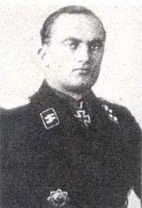Kepplinger, Ludwig (Waffen SS)
- Date of birth:
- December 31st, 1911 (Linz/Upper-Austria, Austria)
- Date of death:
- August 7th, 1944 (Parne sur Roc/Pays de la Loire, France)
- Buried on:
- German War Cemetery Mont-de-Huisnes
Plot: 68. Grave: 168. - Service number:
- SS-Nr.: 116.879 // NSDAP-Nr.:
- Nationality:
- German (1933-1945, Third Reich)
Biography
Career:
00.00.1929: Alpenjäger-Regiment 7, Austria
00.00.1935: SS-Legion, Austria
00.00.1935: entered in the SS-VT
00.00.1940: SS-Hascha, SS-VT, campaaing in the West
10.05.1940: captured Fort Westervoort - fightings in Arnheim, severely WIA at the Grebbe-Line
00.08.1940: promoted to SS-Untersturmführer for bravery
00.00.1941: Führer, 10. Kompanie, SS-Regiment 'Westland', SS-Division (mot.) 'Wiking'
00.00.1943: 2. SS-Panzer-Division 'Das Reich'
00.00.1944: Führer, II. Bataillon, SS-Infanterie-Regiment 17
00.00.1944: SS-Stubaf, Führer, SS-Sturmgeschütz-Abteilung 17, 17. SS-Panzergrenadier-Division 'Götz von Berlichingen'
07.08.1944: SS-Stubaf, KIA 1km West of Villiers-Charlemagne, near Parne sur Roc, Normandy
Do you have more information about this person? Inform us!
- Period:
- Second World War (1939-1945)
- Rank:
- SS-Hauptscharführer (Sergeant Major)
- Awarded on:
- May 16th, 1940
- Period:
- Second World War (1939-1945)
- Rank:
- SS-Hauptscharführer (Sergeant Major)
- Awarded on:
- June 1940
- Period:
- Second World War (1939-1945)
- Rank:
- SS-Hauptscharführer (Sergeant Major)
- Awarded on:
- August 2nd, 1940
- Period:
- Second World War (1939-1945)
- Rank:
- SS-Hauptscharführer (Sergeant Major)
- Unit:
- Zugführer, 11. Kompanie, SS-Infanterie-Regiment "Der Führer", SS-VT
- Awarded on:
- September 4th, 1940
“Kepplinger distinguished himself through his extraordinarily brave conduct during the attack of the III./SS-Rgt. ‘DF’ across the Dutch border at Elten and in the Bataillon’s crossing over the Ijssel near Arnhem. With only 2 men Kepplinger clambered over the destroyed Ijssel bridge with the aim of taking possession of the village of Westervoort, which was bristling with MGs. During the crossing of the river Kepplinger and his two men came under strong fire. Even though the probability of this operation’s success was considerably small, maybe impossible, Kepplinger was able to enter the village in a terrific charge by using every bit of available cover. Then a tough battle began between the 90-man garrison and the 3 German troops. Kepplinger was able to force the surrender of one part of Westervoort after another. This was made possible only via a ruthless disregard of his own life. His soldierly courage shone during this occasion in a way that is rarely exceeded on the battlefield.
By 10:00 the village of Westervoort was in the hands of the 3 SS men. The soldiers of the village, heavily fortified with MGs, had previously held a position that rendered a crossing of the 100 metre wide Ijssel essentially impossible. Now they laid down their arms before a force that was laughably inferior in numbers and equipment.
It should be noted that the German artillery had neither conducted a preparatory barrage nor supported the attack of the 3 SS men.
Without the possibility to request such support during this operation, any rational man would surely not have dared to think success was possible. The fact that it was even so is thanks to the leadership qualities of Hauptscharführer Kepplinger. 1 hour later the III. Bataillon came across the Ijssel in force, and from an elevated portion of the Westervoort position he was able to report to his Bataillon commander that: “Obersturmbannführer, I report that Westervoort has fallen!”
Now only the field positions on both sides of Westervoort remained, with the main strongpoint of this line having fallen into the hands of the 3 SS men. The crossing of rubber boats following appropriate artillery support against the not yet fallen parts of the Westervoort position was now only a matter of time.
An attack of the Bataillon across the Ijssel without control of Westervoort would likely have resulted in a great many soldiers losing their lives.
As the leader responsible for this operation, Kepplinger has the right to possess the title of the bravest NCO in the regiment. The Regiment is grateful to the heroic accomplishment of these 3 SS-men of III. Bataillon for achieving a breakthrough across the Ijssel in a way not thought possible.
In the following battles, which saw the Grebbe position reached, Kepplinger once again distinguished himself in an outstanding way as a Zugführer. Despite being wounded several times, Kepplinger made the choice to remain on the battlefield and once again stormed at the head of his Zug. Only after exhibiting fainting symptoms due to heavy blood loss did Kepplinger give up command of his Zug. After being brought to the main dressing station he was sent immediately to the field hospital.
In summary my assessment is that Kepplinger is an exceedingly brave, death defying soldier. His battlefield conduct commands the highest attention. For this reason I recommend Hauptscharführer Kepplinger of the III./SS-Rgt. ‘DF’ for the award of the Knight’s Cross to the Iron Cross.”
First SS-NCO awarded with the RK
- Period:
- Second World War (1939-1945)
- Period:
- Second World War (1939-1945)
- Rank:
- SS-Obersturmführer (Lieutenant)
- Unit:
- Chef, 10. Kompanie, SS-Regiment "Westland", SS-Division 'Wiking'
- Awarded on:
- February 28th, 1942
- Period:
- Second World War (1939-1945)
- Awarded on:
- 1942
- Period:
- Second World War (1939-1945)
- Awarded on:
- 1942
Sources
- Photo 1: www.death-cards.com
- Photo: Andrew Straube via Death-Cards.com
- - MOONEY, PETER, Waffen-SS Knights and their Battles, Schiffer Pub Ltd, 2008.
- Die Ordensträger der Deutschen Wehrmacht (CD), VMD-Verlag GmbH, Osnabrück, 2002
- Fellgiebel W.P., Elite of the Third Reich, The recipients of the Knight's Cross of the Iron Cross 1939-1945: A Reference, Helion & Company Limited, Solihull, 2003, ISBN 1-874622-46-9
- Patzwall K., Scherzer V., Das Deutsche Kreuz 1941-1945, Geschichte und Inhaber Band II, Verlag Klaus D. Patzwall, Norderstedt, 2001, ISBN 3-931533-45-X
- Andrew Straube via Death-Cards.com











